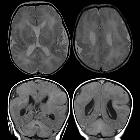Makrozephalie

Hochgradige
Stenose des Foramen magnum bei Chondroplasie mit Ausbildung eines Hydrocephalus. Kinking der Medulla oblongata, jedoch noch keine Myelopathie.

Newborn with
macrocephaly. Axial T2 (above) and coronal T1 (below) MRI without contrast of the brain shows small haphazard appearing gyri and too few sulci present bilaterally, primarily in the sylvian fissures.The diagnosis was bilateral perisylvian polymicrogyria.

Macrocephaly
• Mucopolysaccharidoses - Ganzer Fall bei Radiopaedia

Macrocephaly
• Achondroplasia - Ganzer Fall bei Radiopaedia

Macrocephaly
• Mucopolysaccharidosis - Ganzer Fall bei Radiopaedia
 nicht verwechseln mit: Makroenzephalie
nicht verwechseln mit: MakroenzephalieMacrocephaly is a clinical and radiological term that refers to a generalized increase in the size of the cranial vault.
Terminology
This slightly differs from the term megalencephaly which means an increase in the size of the brain parenchyma.
Epidemiology
content pending
Clinical presentation
content pending
Pathology
In an infant it can result from a wide range of causes:
- congenital hydrocephalus: this, in turn, can result from a multitude of causes
- hydranencephaly: the choroid still forms CSF
- subdural fluid collection
- neurofibromatosis type 1
- achondroplasia
- hypochondroplasia
- thanatophoric dysplasia
- tuberous sclerosis complex
- metabolic storage diseases, e.g. mucopolysaccharidoses
- Alexander disease
- Greig syndrome
- Gorlin-Goltz syndrome
- Ruvalcaba syndrome
- Canavan disease
- cranio-cerebello-cardiac (CCC) syndrome
- Sotos syndrome
- Bannayan–Riley–Ruvalcaba syndrome (BRRS)
Radiographic features
Some define the condition on skull radiography when the head circumference is more than 2 standard deviations above the mean or exceeds the 97percentile by at least 0.5 cm .
See also
- benign enlargement of the subarachnoid spaces in infancy as a benign cause of macrocephaly
- fetal macrocephaly
Siehe auch:
- Tuberöse Sklerose
- Neurofibromatose Typ 1
- Achondroplasie
- Gorlin-Goltz-Syndrom
- Thanatophore Dysplasie
- Mukopolysaccharidose
- Morbus Alexander
- Morbus Canavan
- Greig-Syndrom
- Sotos-Syndrom
- Megaloenzephalie
- kongenitaler Hydrozephalus
- Hydranenzephalie
- benign enlargement of the subarachnoid spaces in infancy
und weiter:
- neuroradiologisches Curriculum
- Aquäduktstenose
- benigne Erweiterung des Subarachnoidalraums bei Kindern
- bilateral megalencephaly
- Mukopolysaccharidose Typ I-H
- fetale Hirntumoren
- kongenitale Aquäduktstenose
- Clark-Baraitser-Syndrom
- kortikale Malformation
- bannayan zonana syndrome
- Johnson-Syndrom
- Weaver-Syndrom
- tay sachs disease
- Fukosidose

 Assoziationen und Differentialdiagnosen zu Makrozephalie:
Assoziationen und Differentialdiagnosen zu Makrozephalie:











